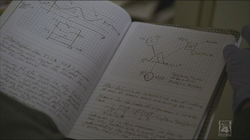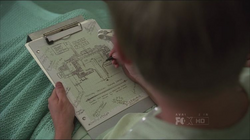SteveHFisyh (talk | contribs) Tags: Visual edit apiedit |
No edit summary Tag: rte-source |
||
| Line 1: | Line 1: | ||
{{Character |
{{Character |
||
|name=James Sidas |
|name=James Sidas |
||
| − | |image= James Sidas.png |
+ | |image= Image:James Sidas.png |
|age=32 |
|age=32 |
||
|occupation=Courier |
|occupation=Courier |
||
| Line 61: | Line 61: | ||
[[Category:Males]] |
[[Category:Males]] |
||
[[Category:Characters]] |
[[Category:Characters]] |
||
| − | [[Category:Season 6]] |
||
Revision as of 02:06, 2 July 2017
James Sidas is an exceptionally brilliant physicist and author who traded his successful career for a job as a courier. The youngest person to ever graduate MIT, he has an IQ of 178 and published three books and 35 papers all before the age of 18. He is portrayed by actor Esteban Powell. It is possible that Shore based Sidas on William James Sidis, a mathematical and linguistic prodigy.
Case History
Sidas was admitted to hospital when he found himself disoriented and unable to control the movement of his hand. On examination, he was found to have ataxia, anemia and a mild cough. His CT Scan was clear and his tox screen was negative. Dr. Hadley thought it might be a virus like West Nile virus. However, Sidas had no fever and his lymph nodes weren't swollen. Dr. Taub thought it might be hyperbilirubinemia, and Dr. Chase thought it was meningitis. Dr. Taub suggested sickle cell anemia even though the patient was of European descent. Dr. Foreman thought it was Thrombotic thrombocytopenic purpura and Dr. Hadley and Dr. Chase agreed. Dr. House cut off the discussion and ordered a blood smear to confirm and a test of his ADAMTS13 antibodies.

Back Cover of Sidas' Book
Dr. Hadley reported the diagnosis to Sidas and his wife. She told them TTP wasn't curable, but it was treatable. Dr. Taub started to ask why he wasn't working at a better job, but Sidas realized that Dr. Taub was trying to find out if he was an alcoholic or drug addict. Dr. Taub also asked if he had a history of mental illness. Sidas assured him he was working as a courier by choice and he was happy doing it.
Dr. Taub asked Dr. Hadley if she found anything odd about Sidas. She said he seemed normal, but Dr. Taub said that was the problem - people with high IQs generally don't act normal. Sidas's blood tested positive for schistocytes, confirming TTP. However, Dr. Taub thought it wasn't the whole story - the case was too easy for Dr. House. He figured there was another condition and Dr. House was testing his fellows to find out if they would catch on.
Dr. Taub and Dr. Hadley reported the results to Dr. House, but they said that plasmapheresis wasn't an option because the patient had an albumen colloid allergy. The alternative was a spleenectomy. Dr. House agreed. When Dr. Taub asked him why he took such an easy case, Dr. House said he wanted to meet the patient.
The surgery went well and Sidas appeared to be recovering. He would need long term medication, but Dr. Chase assured Sidas that he would be released in about a week if everything went well. However, when Sidas started talking, he wasn't making sense. His vital signs monitor set off an alarm. After examining him, Dr. Chase realized he was having a stroke. He was given oxygen.
Sidas's stroke was successfully treated and there was no permananent brain damage. However, it appeared that they had done the spleenectomy for nothing. Although the symptoms and tests all pointed to TTP, it wouldn't explain why he failed to improve after the spleenectomy. Dr. Taub thought it might be CNS vasculitis, but something would have shown up on the CT Scan. Dr. Hadley thought it might be DIC, but there was no hemmorhaging. Dr. Taub suggested acquired pancytopenia, but the patient's WBC count was normal. Dr. Foreman thought it might be a toxin and Dr. Chase pointed out non-standard toxins don't show up on a tox screen. Dr. House ordered an environmental scan and tests for non-standard toxins that might cause the symptoms.

Old Physics Notebook
Dr. Taub and Dr. Chase did the environmental scan. Dr. Chase found ibuprofen, nose drops and cough syrup. Dr. Taub found signs of mice and realized leptospirosis could have caused the ataxia and anemia, but Dr. Chase thought he would have to have a fever. They also found his old physics notebooks which were at least 14 years old. Dr. Taub realized that Sidas was passionate about physics in his youth and couldn't figure out why he gave it up. However, Dr. chase then noticed an air vent was loose and found a large empty vodka bottle.
The screen for other toxins was also negative. Dr. Chase thought it was liver failure from alcohol. Dr. House ordered Dr. Taub and Dr. Hadley to do a liver biopsy even though they were about to leave for Thanksgiving.
Sidas denied being an alcoholic, but his wife was surprised he drank at all. Dr. Taub performed the biopsy, but Sidas thought it was a waste of time. However, the results showed no cirrhosis, scarring or infection. The blood tests showed only one abnormal result, an albumen level of 7.2. That could be explained by kidney failure. It would also explain the anemia and if he developed hyperkalemia it would explain the ataxia. The stroke could be explained by ischemic encepalopathy. However, they realized they would have to stay to test his kidneys.
Dr. House was away the following day so Dr. Foreman started the new differential for kidney failure. Dr. Hadley thought it might be rhabdomyolysis, but there was no edema. Dr. Chase thought it might be multiple myeloma, but there was no bone pain. He then suggested polycystic kidney disease, but there were no UTIs or flank pain. Dr. Chase started thinking about the cough the patient had at admission. Dr. Hadley said the patient wasn't coughing now, but Dr. Chase had also found cough syrup. Dr. Taub thought it might be Goodpasture's syndrome, which would affect the kidneys and lungs. Dr. Foreman wanted to start him on immunosuppressants and dialysis. Dr. Hadley wanted to check with Dr. House, but as the rest of the team was in agreement, they decided that it wasn't necessary.
They told Sidas he would need to be on dialysis for 4-6 hours a day until they saw improvement. If they didn't see improvement, he would need a transplant.
However, Dr. House returned to the hospital realizing that Sidas' lack of intelligence was the sign of dextromethorphan abuse. He was deliberately using it to lower his intelligence as it was cheap and widely available. However, he would suffer permanent brain damage unless he also used alcohol to counter the effect, explaining the vodka bottle. He admitted he did it to feel less miserable. Dr. House told him that the dextromethorphan abuse explained all his symptoms. Dr. House ordered a lavage of his small intestine and activated charcoal to remove it from his system.

Schematic for a Toroidal Helicon Plasma Device
Sidas started to improve and he began work in applied physics, "doodling" a schematic for a toroidal helicon plasma device. However, he confided in Dr. Foreman that he was feeling miserable again and that he felt less attracted to his wife. He admitted he was a jerk and he owed her everything, but he didn't want to be with her.
Even his wife realized that he had changed and didn't want to be with her anymore. Dr. Foreman tried to assure her that it was just withdrawal symptoms. However, Sidas called for help. He said he couldn't feel anything in his legs. Dr. Foreman realized he was unresponsive to stimuli - paralysis.
Dr. Hadley suggested Vitamin B12 deficiency, which would explain the anemia and numbness, but wouldn't explain the stroke. Dr. Hadley thought it might be a vascular malformation, but the anemia wasn't macrocytic. Dr. Foreman suggested a bone marrow malignancy, but this would not explain the schistocytes. Dr. Taub suggested lupus, but his ANA was negative.

Dara Sidas
Dr. House went to the patient for assistance, but he didn't think he would be able to help. Sidas admitted that twelve years before, he tried to commit suicide by jumping off an 8 story building into a dumpster. He broke a leg and three ribs. While he was on narcotics, he realized he wasn't as intelligent and it made him less depressed, isolated and lonely. That's when he met his wife - she was dumb (IQ 87) and happy, and he realized he wanted to stay less intelligent forever. Dr. House felt empathy for the like-minded individual and gave him a bottle of cough syrup, so that "Einstein could give himself a lobotomy". However, he also realized his broken ribs might be relevant. Sidas confirmed he broke the bottom three on his left side, just where his spleen was.
Dr. House planned an MRI with ferrous oxide contrast because it would be absorbed by the spleen. However, he realized if the patient had no spleen, the contrast would be absorbed by the liver and would severely damage it. Dr. Chase was incredulous that Dr. House thought he would operate and not remove the spleen. However, when they did the scan, they found several accessory spleens, most likely created when his spleen was damaged by his broken ribs. They realized it was TTP all along, Dr. Chase just didn't remove all of the spleens - there were 16 remaining that had to be removed. Dr. Chase planned more surgery.
The further surgeries went well. However, Sidas admitted he was going to return to dextromethorphan abuse.
